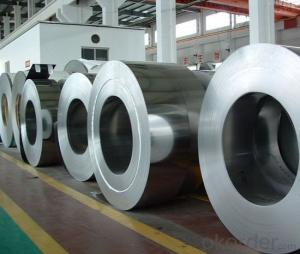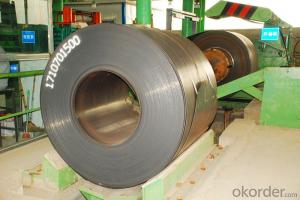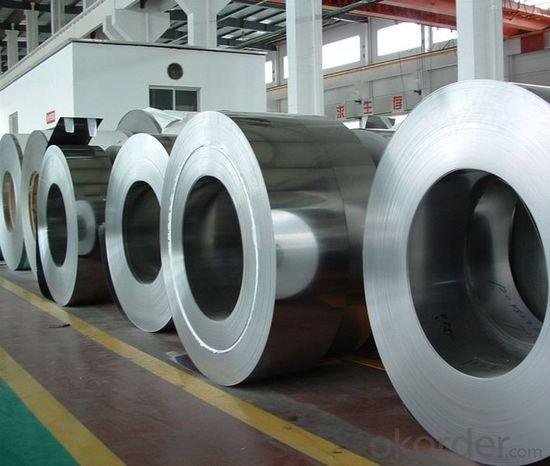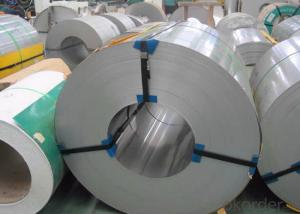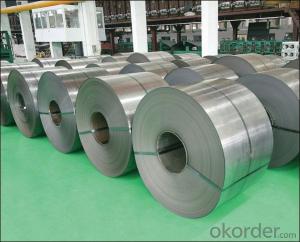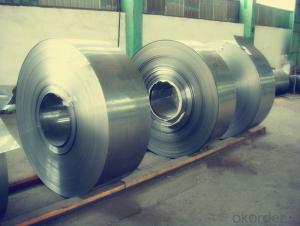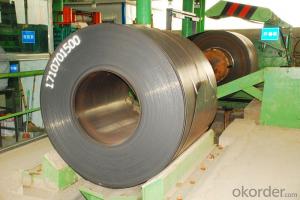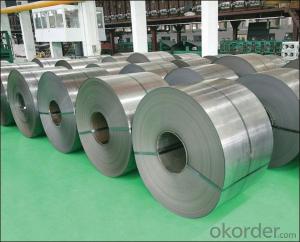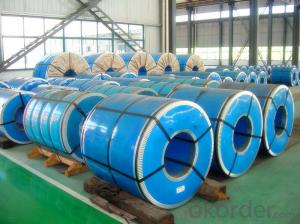Hot Rolled Stainless Steel Coil 201 Narrow Strip
OKorder Service Pledge
OKorder Financial Service
You Might Also Like
Hot Rolled Stainless Steel Coil 201 No.1 Finish Narrow Strip
Hot Rolled Stainless Steel 201 half copper Chemical Composition(%) | |||||||
C | Si | Mn | P | S | Ni | Cr | Cu |
0.1 | 0.5 | 10 | 0.04 | 0.01 | 1.20/1.30 | 13.00/14.00 | 0.8/1.0 |
Grade: | 200 Series | Standard: | JIS,AISI,ASTM,GB,DIN | Thickness: | 2.5/3.0/4.0mm |
Width: | 485/510/550/610/1010/1240mm | Place of Origin: | Shanghai China (Mainland) | Brand Name: | CNBM |
Model Number: | 201 | Technique: | Hot Rolled | Application: | Industrial tubes/kitchen/bath |
Certification: | ISO | THK: | 2.5/3.0/4.0mm | Face: | No.1 |
Usage: | tubes/kitchen/bath | Origin: | CHINA | ||
201 Hot Rolled Stainless Steel Coil Specifications
THK:2.3/2.5/3.0/4.0mm
Width:485/510/550mm
Face:No.1
201 Hot rolled stainless steel Coil Application
Stainless steel is a production which not easy rust,acid resistance and corrosion resistance,so it is widely
used in light industry,heavy industry,daily necessities and the decoration industry.201 hot rolled stainless steel coil, use to produce cold rolled stainless ste
-el coil and stainless steel tube, pipe.
201 Hot Rolled Stainless Steel Coil
Strength Of Extension:100,000 To 180,000 Psi;
Yield Strength:50,000 To 150,000 Psi
Elongation :55 To 60%;
Modulus Of Elasticity:29,000,000 Psi;
Density :.280lbs/Cubic Inch(7.93g/Cm3)
- Q: What are the different types of stainless steel strips?
- There are several different types of stainless steel strips, each with unique properties and applications. Some commonly used types include: 1. Austenitic Stainless Steel: This type is the most commonly used and has excellent corrosion resistance. It is non-magnetic, easily formable, and ideal for applications where high strength and good weldability are required. 2. Ferritic Stainless Steel: Ferritic strips are magnetic and have good corrosion resistance. They are less formable than austenitic stainless steel but have higher strength and are commonly used in automotive exhaust systems, decorative applications, and appliances. 3. Martensitic Stainless Steel: Martensitic strips are known for their high strength and hardness. They have moderate corrosion resistance and are often used in applications that require wear resistance, such as knives, blades, and turbine parts. 4. Duplex Stainless Steel: Duplex stainless steel strips combine the properties of both austenitic and ferritic stainless steels. They have excellent corrosion resistance, high strength, and good weldability. They are commonly used in industries such as oil and gas, chemical processing, and marine applications. 5. Precipitation Hardening Stainless Steel: Precipitation hardening strips have a unique combination of high strength and corrosion resistance. They can be heat treated to achieve even higher strength levels, making them suitable for aerospace and high-performance applications. It is essential to choose the right type of stainless steel strip based on the specific requirements of the application, such as corrosion resistance, strength, formability, and magnetic properties.
- Q: Can 111 stainless steel strips be used in the chemical processing industry?
- Yes, 111 stainless steel strips can be used in the chemical processing industry. 111 stainless steel is a low carbon variation of the 300 series stainless steels, which are known for their excellent corrosion resistance properties. This makes them suitable for use in environments with high levels of chemicals and corrosive substances. Additionally, 111 stainless steel strips possess good strength, toughness, and formability, making them ideal for various applications in the chemical processing industry, such as tanks, pipes, valves, and other equipment. However, it is important to consider the specific requirements and conditions of a particular chemical processing operation to ensure that 111 stainless steel is compatible and appropriate for the specific application.
- Q: Can stainless steel strips be used in food processing equipment?
- Food processing equipment can indeed make use of stainless steel strips. Within the food industry, stainless steel is a favored choice due to its numerous desirable qualities. Its exceptional corrosion resistance is particularly crucial in an environment where contact with both food and water is common. Furthermore, stainless steel is easy to clean and sanitize, making it well-suited for food processing equipment that requires frequent washing. In addition, stainless steel does not react with food, ensuring that no harmful substances are leached into the processed products. Its durability and strength also guarantee that the equipment can withstand the rigorous demands of the food processing industry. In summary, stainless steel strips are a dependable and secure option for food processing equipment.
- Q: Can stainless steel strips be used in kitchenware?
- Yes, stainless steel strips can be used in kitchenware. Stainless steel is a popular choice for kitchenware due to its durability, resistance to corrosion, and ease of cleaning. Stainless steel strips can be used to make various kitchen utensils, cookware, and appliances, making them a suitable material for kitchenware applications.
- Q: Are stainless steel strips suitable for elevator interiors?
- Elevator interiors can benefit from the use of stainless steel strips, which are highly suitable for this purpose. Stainless steel is a versatile and durable material that finds widespread use in various applications, including elevator interiors. Its exceptional properties make it an ideal choice for this application, as it resists corrosion, requires minimal maintenance, and maintains a polished and sleek appearance over time. By incorporating stainless steel strips, the elevator interior's aesthetic appeal can be enhanced, resulting in a modern and sophisticated look. Moreover, stainless steel is easy to clean and sanitize, ensuring a hygienic environment, especially in areas with high foot traffic. In conclusion, stainless steel strips offer a practical and suitable option for elevator interiors, combining durability and aesthetic charm.
- Q: Can stainless steel strips be used in medical equipment?
- Yes, stainless steel strips can be used in medical equipment. Stainless steel is commonly used in the medical industry due to its excellent corrosion resistance, durability, and ease of sterilization. It is often utilized in medical instruments, surgical tools, implants, and medical device components.
- Q: Can stainless steel strips be coated with protective films?
- Stainless steel strips have the capability to be coated with protective films, which are usually employed to safeguard the surfaces of stainless steel during transportation, storage, and fabrication processes. These films have been specifically designed to offer temporary protection against scratches, abrasions, dirt, and other types of damage. Typically, these films are transparent or translucent, allowing for effortless inspection of the stainless steel surface while providing effective protection. Applying and removing these films is a simple task, and they leave the stainless steel strip in its original state. Protective films are extensively utilized in a range of industries such as automotive, construction, electronics, and appliances, to guarantee that stainless steel products maintain their immaculate appearance until they are ready for use.
- Q: Can stainless steel strips be painted or coated?
- Yes, stainless steel strips can be painted or coated.
- Q: How are stainless steel strips different from carbon steel strips?
- Stainless steel strips differ from carbon steel strips primarily in their composition and properties. Stainless steel is a corrosion-resistant alloy that contains a minimum of 10.5% chromium, which forms a protective oxide layer on its surface. This oxide layer prevents rusting and corrosion, making stainless steel strips ideal for applications where durability and resistance to moisture or chemicals are required. Carbon steel, on the other hand, is primarily composed of iron and carbon, with no additional alloying elements like chromium. While carbon steel is generally stronger and more rigid than stainless steel, it is more prone to rust and corrosion. Therefore, carbon steel strips are often used in applications where strength is crucial, while stainless steel strips are preferred for their corrosion resistance.
- Q: Can stainless steel strips be easily welded?
- Certainly, welding stainless steel strips is a breeze. Renowned for its remarkable weldability owing to its elevated melting point, limited thermal conductivity, and commendable heat resistance, stainless steel shines. TIG (Tungsten Inert Gas) welding and MIG (Metal Inert Gas) welding are the go-to techniques for welding stainless steel strips. These methods facilitate meticulous regulation of the welding procedure and yield robust and long-lasting welds. Furthermore, stainless steel strips frequently find their way into diverse sectors such as automotive, construction, and manufacturing, where welding serves as a prevalent method of joining.
Send your message to us
Hot Rolled Stainless Steel Coil 201 Narrow Strip
OKorder Service Pledge
OKorder Financial Service
Similar products
Hot products
Hot Searches
Related keywords
